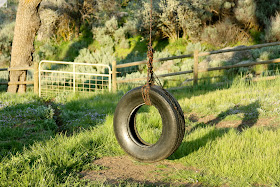Welcome to the first Monday Homestead Barn Hop! This is your chance to share what's going on at your own homestead and link up with others who are reviving the back to basics movement. Join up with...
• Jill @ The Prairie Homestead
• Kendra @ New Life on a Homestead
• Megan @ A Blossoming Homestead
• and Me, right here!
I thought it would be fun to show you around my own property this week, beginning with a layout of the land. My homestead is situated on nearly 4.5 acres in the Sierra Nevada mountains, so we get the cool nights and warmer days because the High Desert is so close. Those cool nights can make things tough at times - like gardening, even in the summer! On the upside, I don't have to run an air conditioner!
Keep in mind this drawing is not to scale. In fact, the garden looks longer and narrower than it really is. But for the most part, it's pretty accurate and gives you an idea of what I'm dealing with. Most of our property is actually mountainside (look in the background of each photo for an idea), so terracing is a must. Even in the garden and play area it is sloped, so nothing is truly flat. (If you click on the photo, I think it will make it larger and easier to see).
 |
| July 2010 |
The play area is nice and large with huge oak trees shading most of it. We are hoping to eventually plant a low water grass to keep the dirt from being such an issue! Without rain each summer, we would have to water it and that really isn't something we want to do. Once or twice during the summer would be one thing, but weekly? $$$! So I've found some seed at High Desert Gardens that I want to try this summer.
 |
| Chicken Coop 2010 |
The chicken coop (or the Hen Hilton as we fondly call it), is almost finished. We still need to hook up the electricity and water, install windows, and add some plants (see my dream coop here). And I would like a few window boxes for charm! The yard is plenty large enough for the "girls" to scratch and peck and I occasionally let them run in the garden. Also, there is a small run that they can go into directly from the coop - day or night - and still be fully protected. That way they can stretch each morning until we get out there to let them out.
 |
| The Garden 2010 |
The garden is really a mess in this picture. Strictly functional, not beautiful, and in need of weeding, but it was the only photo I could find that gave a large view of it. I call it a potager garden, but only because I grow both flowers and vegetables in it (and nothing was blooming at the time). But I've got big plans and I hope to eventually post some before and after pics. This just goes to show that my homestead is NOT perfect (lest anyone seriously thought so!). And this would be a good time for me to mention that no homestead is ever perfect. Each location has it's own pros and cons; and you must focus on what you can change and work with what you have! Anyway, it started out small and has grown each year. I'll do a better tour of it on another Homestead Barn Hop.
 |
| The garden has since gone in back by the fence |
Behind the garden is an a small patch of ground just before the dry creek bed where we plan to plant some fruit trees; actually, it's no longer a dry creek bed. After 8 years on the property, it has had running water most of the winter this year due to all the rain. I love it! I wish it always had water! Both apples and cherries do really well here, as do a few other fruits including berries, however, they will have to be fenced to protect the trees and bushes from deer and elk.
 |
| A portion of the yard where the kids play on a zip line and bungie swing |
Still to come are the goats and beehives. The bees will go under an oak tree outside the fence so that they are shaded a bit during the summer, but get some sun during the winter. The only negative is that this is a north facing slope. I'm still not 100% set on this location, but after two years of thinking on it, it's the best I could come up with unless I actually kept them in the yard. The kids begged me not to.
 |
| Tire Swing in the yard and somewhere to the right is a trampoline |
And the rest of the 3 1/2 acres? Well, if we were younger, I'd terrace it for lavender or grapes. And don't think I've ruled it out completely! You never know!
Link Up Your Homestead
Now it's your turn! Write a post on something about your homestead, or something you're doing on your homestead, or any homesteading topic. Then come back here, click the Linky, add your caption, a URL, and a photo so that we can hop on over to your homestead and visit! Please be sure to add the cute Homestead Barn Hop picture to your post and link it back to one of our four host blogs so that others can participate in the fun, too!















































